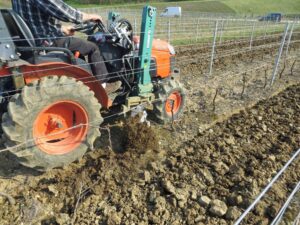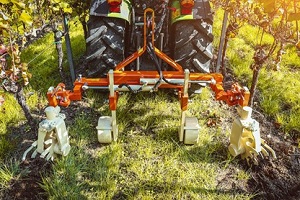Background
Most growers use a combination of different tools to achieve good weed control. Cultivation tools are some of the most common.
Disc ploughs and rotary tillers have the same working principles – an off-set disc moving soil sideways – although some disc ploughs are also hydraulically driven.

Figure 1. Clemens Disc Plough (courtesy of http://www.clemens.com.au/browse-products/Viticultural-Equipment/SERRATED-DISK-PLOUGH-(GSP))
Action
Disc ploughs and rotary tillers are used to loosen soil and disturb weeds. They can also be used in combination with other tools such as finger weeders or knife weeders to improve the efficacy and speed of the operation.
Powered disc ploughs and rotary tillers are more aggressive and have a faster operating speed than draft discs and tillers. The angle of some models can be adjusted to change how aggressively they work as well as the width of the cultivated area.
Disc ploughs and rotary tillers can be used to manage weeds along the vine edge, or they can be mounted on a hydraulic tool carrier for undervine weeding.
Disc ploughs (Figure 1) mound the soil and create a straight cut which may increase the risk of erosion on sloping vineyards. In comparison, the offset position of the stars of rotary tillers (Figure 2) does not create a clean, straight cut, thereby reducing the risk of erosion on sloping vineyards.

Figure 2. Braun rotary star tiller (image courtesy of Braun)
Disc ploughs operate at a slower speed than rotary tillers – 7 km/h compared to 12 km/h. Disc ploughs are less effective at breaking up the soil and dislodging weed roots than rotary tillers, increasing the risk of the weeds being transplanted.
Advantages and disadvantages
Advantages: Disc ploughs and rotary tillers can improve the efficacy and speed of undervine mechanical weeders and provide medium-term weed control along the vine edge.
Disc ploughs and rotary tillers mounted on hydraulic tool carriers can provide medium-term undervine weed control and when fitted with sensors, cause minimal damage to vines, and require low operator skill.
Disadvantages: Cultivation tools may spread couch and kikuyu if these weeds are allowed to transplant. Repeated cultivation can damage soil structure and reduce soil carbon levels. Power-discs and tillers are more aggressive and damaging to soil structure than draft tools.
Undervine cultivation can cause reductions in vine vigour in the first two years until the vine roots adjust by moving deeper into the soil profile.
Table 1. Advantages and disadvantages of a disc plough
| Ability to reduce weed competition with vines | Good |
| Soil disturbance caused | High |
| Suitability in young vineyards | Poor |
| Length of weed control | Good |
| Operating speed | Average |
| Operating cost | Average |
| Capital cost | High |
Considerations
When considering which weed control tools to use, it is important to base the decision on each vineyard’s individual characteristics. Factors such as soil type and condition, slope, rainfall and water availability, weed type and pressure, vine age, vine vigour, fruit end-use targets, weather conditions, and compatibility with existing infrastructure and equipment should all be considered.
Table 2. Ease of using a disc plough or rotary tiller on different soil types
| Large or excessive stones | Difficult |
| Stone/gravel | Moderate |
| Sand | Easy |
| Silt/loam | Easy |
| Clay | Moderate (can be difficult in wet or very dry soils) |
Cultivation tips
- Control weeds when they are small.
- Mechanical undervine weed control is most effective in hot, dry weather with dry soils, but care is required to minimise damage to soil structure.
- Multiple passes may be required if the soils are heavily compacted.
- Using a finger weeder in combination with another cultivation tools such as a disc plough may be beneficial.
- Cultivation may be difficult in very wet or very dry conditions.
Growers’ experiences
Handpicked Wines in the cool climate region of the Yarra Valley, Victoria uses a combination of different weeders to manage weeds on its sandy loam soils over clay and gravel over mudstone soils. A Clemens knife weeder fitted with a rotary tiller head used in combination with a Clemens finger weeder fitted with a rotating disc plough provides good results without being too slow. The slower knife weeder, with an operating speed of 7 km/h, is used early in the season to cut weeds off underground and lightly cultivate the soil. The finger weeder with a 12 km/h operating speed is used for several quick clean-up passes during the growing season. The knife weeder and finger weeder can leave tougher weeds with thicker stems, such as mallow, behind. To manage these weeds, a more aggressive dodge plough is used every few years.
Resources
Organic Winegrowers New Zealand. 2017. Undervine weed management – A practical guide to effective weed control in organic vineyards.
Contact
For further information, please contact:
AWRI helpdesk
Phone 08 8313 6600 Email helpdesk@awri.com.au

